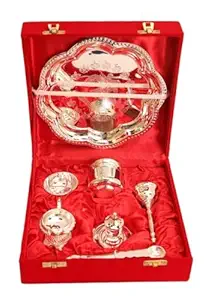नवरात्रि: दिव्य पूजन की नौ रातें
नवरात्रि, एक प्रशासनिक और आध्यात्मिक दिनों के हिन्दू त्योहार है, जिसे भारत और दुनिया भर के हिन्दू लोग उत्साह और भक्ति के साथ मनाते हैं। "नवरात्रि" शब्द दो संस्कृत शब्दों से लिया गया है: "नव" जिसका अर्थ होता है नौ और "रात्रि" जिसका अर्थ होता है रात। जैसा कि नाम से ही सूचित होता है, नवरात्रि नौ रातों का दिन है और इसे प्रमुख रूप से देवी दुर्गा, उसके विभिन्न रूपों की पूजा के लिए समर्पित किया जाता है। इस विस्तृत ब्लॉग में, हम नवरात्रि के महत्व, रितुअल्स, और सांस्कृतिक पहलुओं को जानेंगे।
नवरात्रि का महत्व:
नवरात्रि दिव्यता के अनेक रूपों में माता दुर्गा की पूजा को समर्पित करने के लिए मनाया जाता है। यह त्योहार अच्छे को बुरे पर विजय की जीत की प्रतीक्षा करता है, जिसमें सबसे प्रमुख कथा माता दुर्गा और राक्षस महिषासुर के बीच के युद्ध की है। माना जाता है कि इन नौ रातों के दौरान देवी मां अपने भक्तों को शक्ति, ज्ञान, और समृद्धि के साथ आशीर्वाद देने के लिए पृथ्वी पर आती हैं।
मां दुर्गा के नौ रूप:
नवरात्रि की हर रात मां दुर्गा के एक रूप को समर्पित है। इन रूपों में शामिल हैं:
-
शैलपुत्री: पहली रात को शैलपुत्री को समर्पित किया जाता है, जिन्हें हिमालय की पुत्री के रूप में दिखाया गया है। वे पवित्रता के प्रतीक हैं।
-
ब्रह्मचारिणी: दूसरी रात को मां दुर्गा के रूप ब्रह्मचारिणी की पूजा की जाती है। वे ज्ञान और बुद्धि की प्राप्ति का प्रतीक हैं।
-
चंद्रघंटा: तीसरी रात को चंद्रघंटा का पूजन किया जाता है, जो अपने बहादुरी और साहस के लिए प्रसिद्ध हैं।
-
कुश्मांडा: चौथी रात को कुश्मांडा का पूजन किया जाता है। माना जाता है कि वे ब्रह्मांड के निर्माता हैं और सूर्य की गर्मी और ऊर्जा से जुड़े हैं।
-
स्कंदमाता: पांचवी रात पर स्कंदमाता का समर्पण होता है, जो भगवान कार्तिकेय (स्कंद) की मां हैं, मातृ भक्ति और करुणा का प्रतीक होती हैं।
-
कात्यायनी: छठी रात को कात्यायनी का समर्पण होता है, जो ज्ञान की शक्ति का प्रतीक हैं।
-
कालरात्रि: सातवीं रात को कालरात्रि का पूजन किया जाता है। वे दुर्गाशक्ति की एक भयानक रूप हैं जो बुराई के बाहर करती हैं।
-
महागौरी: आठवीं रात को महागौरी का पूजन किया जाता है, जो पवित्रता और तप का प्रतीक हैं।
-
सिद्धिदात्री: नौवीं और अंतिम रात को सिद्धिदात्री का समर्पण होता है, जो अद्भुत शक्तियों और आशीर्वादों की देने वाली हैं।
नवरात्रि मनाओ:
-
उपवास: बहुत सारे भक्त नवरात्रि के दौरान उपवास करते हैं, जिसमें कुछ खाने पीने की विशेष बातें नहीं करते। कुछ लोग नौ दिनों के दौरान पूरी तरह से उपवास रखते हैं।
-
गरबा और दंडिया रास: नवरात्रि का एक बड़ा हाइलाइट गरबा और दंडिया रास के नृत्य प्रस्तुतियों है। लोग बड़े समृद्धि से ताल और गीतों पर नृत्य करने के लिए रंगीन वस्त्र पहने हुए बड़े समृद्धि से ताल और गीतों पर नृत्य करते हैं।
-
कोलू या गोलू: दक्षिण भारत में, परिवार वाले "कोलू" या "गोलू" प्रदर्शन करते हैं, जिसमें विभिन्न देवताओं और हिन्दू पौराणिक कथाओं के दृश्यों की प्रतिस्थिति होती है।
-
आरती और पूजा: घरों और मंदिरों में रोजाना पूजा और आरती (लैम्पों को हिलाने के आयाति) की जाती है। भक्त देवी को फूल, धूप, और अन्य आयातियों की प्रस्तुतियाँ देते हैं।
-
प्रदर्शन: कुछ क्षेत्रों में, देवी की मूर्तियों के साथ प्रदर्शन धूमधाम से किया जाता है।
-
समुदाय जुटना: नवरात्रि समुदायों को एक साथ लाता है, क्योंकि लोग उत्सव में भाग लेते हैं, भोजन साझा करते हैं, और सांस्कृतिक कार्यक्रमों में भाग लेते हैं।
दशमी - विजयादशमी:
नवरात्रि दशमी, जिसे दशहरा के रूप में भी जाना जाता है, के साथ समाप्त होती है, जिसमें भगवान राम की राक्षस राजा रावण पर विजय का जश्न मनाया जाता है। रावण की पुतलियाँ दिखाने और जलाने के द्रामात्मिक प्रदर्शनों के साथ, यह अच्छे को बुरे पर विजय की प्रतीक्षा करता है।
संक्षेप में कहें तो, नवरात्रि एक आध्यात्मिक चिंतन, भक्ति और उत्सव का समय है। इससे यह पुनः साबित होता है कि आस्था का महत्व और दिव्य फेमिनिन की शक्ति हिन्दू लाखों लोगों के जीवन में है। त्योहार की रंगीन परंपराएँ और सांस्कृतिक महत्व इसे सच्चा और खुशी खुशी अवसर बनाते हैं, जिसे सभी को मनाने का अवसर मिलता है।
Introduction
Overview of Navratri
Navratri is a nine-day festival dedicated to Goddess Durga celebrating the victory of good over evil.
Significance of Navratri
Navratri symbolizes spiritual growth devotion and the triumph of righteousness.
Navratri in Different Regions
Navratri is celebrated with unique customs rituals and cultural traditions across India.
Historical Background
Navratri has been observed for centuries to honor Goddess Durga and her nine forms.
Importance of Devotion
Observing Navratri encourages devotion prayer and connection with divine energy.
Festive Rituals
Daily Worship and Aarti
Each day of Navratri involves worship aarti and offering prayers to the Goddess.
Fasting Practices
Devotees observe fasting for spiritual purification health benefits and self-discipline.
Garba and Dandiya Traditions
People celebrate Navratri with vibrant Garba and Dandiya dance performances in honor of the Goddess.
Decorations and Altar Setup
Homes and temples are decorated with flowers lights and idols for worship during Navratri.
Special Prayers and Bhajans
Reciting bhajans and prayers enhances spiritual energy and devotion during the festival.
Goddess Worship
Nine Forms of Goddess Durga
Each day of Navratri is dedicated to a different form of Goddess Durga with specific attributes and significance.
Shakti and Divine Energy
Navratri celebrates Shakti the divine feminine energy that empowers and protects devotees.
Mantras and Chalisa Recitation
Reciting Durga mantras and chalisa brings blessings protection and spiritual growth.
Symbolism of Colors
Each day of Navratri has a specific color representing energy purity and devotion of the Goddess.
Offerings and Prasad
Offerings of fruits flowers and sweets are presented to the Goddess as a mark of devotion.
Spiritual Benefits
Inner Peace and Positivity
Observing Navratri helps cultivate mental peace positivity and spiritual awareness.
Courage and Strength
Devotees gain courage inner strength and resilience through prayers and rituals of Navratri.
Removal of Obstacles
Faithful worship during Navratri removes negative influences and obstacles in life.
Enhanced Devotion
Participating in Navratri rituals strengthens faith devotion and connection with Goddess Durga.
Prosperity and Well-being
Navratri celebrations bring harmony prosperity and spiritual growth to households.
Navratri Tips
Preparing for Navratri
Plan prayers fasting and rituals in advance to observe Navratri effectively and meaningfully.
Maintaining Discipline
Follow discipline in food sleep and devotion to gain maximum spiritual benefits.
Participating in Community Events
Engage in Garba Dandiya and group prayers to experience collective devotion and energy.
Decorating Homes and Temples
Decorate prayer spaces with flowers lights and idols to create a sacred environment.
Spiritual Reflection
Use Navratri as an opportunity for self-reflection meditation and strengthening faith.
Navratri is a nine-day festival dedicated to Goddess Durga celebrating the victory of good over evil.
Navratri symbolizes spiritual growth devotion and the triumph of righteousness.
Navratri is celebrated with unique customs rituals and cultural traditions across India.
Navratri has been observed for centuries to honor Goddess Durga and her nine forms.
Observing Navratri encourages devotion prayer and connection with divine energy.
Each day of Navratri involves worship aarti and offering prayers to the Goddess.
Devotees observe fasting for spiritual purification health benefits and self-discipline.
People celebrate Navratri with vibrant Garba and Dandiya dance performances in honor of the Goddess.
Homes and temples are decorated with flowers lights and idols for worship during Navratri.
Reciting bhajans and prayers enhances spiritual energy and devotion during the festival.
Each day of Navratri is dedicated to a different form of Goddess Durga with specific attributes and significance.
Navratri celebrates Shakti the divine feminine energy that empowers and protects devotees.
Reciting Durga mantras and chalisa brings blessings protection and spiritual growth.
Each day of Navratri has a specific color representing energy purity and devotion of the Goddess.
Offerings of fruits flowers and sweets are presented to the Goddess as a mark of devotion.
Observing Navratri helps cultivate mental peace positivity and spiritual awareness.
Devotees gain courage inner strength and resilience through prayers and rituals of Navratri.
Faithful worship during Navratri removes negative influences and obstacles in life.
Participating in Navratri rituals strengthens faith devotion and connection with Goddess Durga.
Navratri celebrations bring harmony prosperity and spiritual growth to households.
Plan prayers fasting and rituals in advance to observe Navratri effectively and meaningfully.
Follow discipline in food sleep and devotion to gain maximum spiritual benefits.
Engage in Garba Dandiya and group prayers to experience collective devotion and energy.
Decorate prayer spaces with flowers lights and idols to create a sacred environment.
Use Navratri as an opportunity for self-reflection meditation and strengthening faith.


